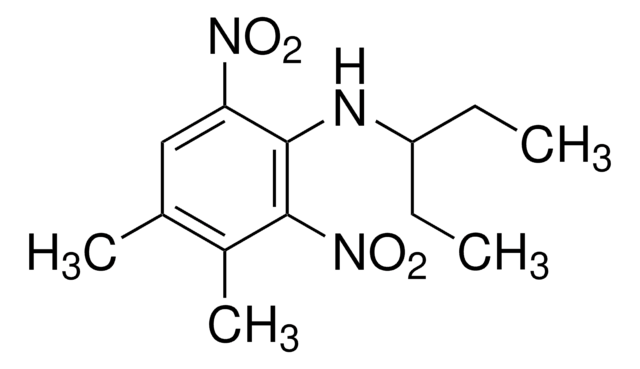D67820
2,6-Dichloro-4-nitroaniline
96%
Synonym(s):
Dichloran
Sign Into View Organizational & Contract Pricing
All Photos(1)
About This Item
Linear Formula:
Cl2C6H2(NO2)NH2
CAS Number:
Molecular Weight:
207.01
Beilstein:
1459581
EC Number:
MDL number:
UNSPSC Code:
12352100
PubChem Substance ID:
NACRES:
NA.22
Recommended Products
Assay
96%
form
powder
mp
190-192 °C (lit.)
SMILES string
Nc1c(Cl)cc(cc1Cl)[N+]([O-])=O
InChI
1S/C6H4Cl2N2O2/c7-4-1-3(10(11)12)2-5(8)6(4)9/h1-2H,9H2
InChI key
BIXZHMJUSMUDOQ-UHFFFAOYSA-N
Looking for similar products? Visit Product Comparison Guide
Related Categories
Signal Word
Danger
Hazard Statements
Precautionary Statements
Hazard Classifications
Acute Tox. 1 Dermal - Acute Tox. 2 Inhalation - Acute Tox. 2 Oral - Aquatic Chronic 1 - STOT RE 2
Storage Class Code
6.1A - Combustible acute toxic Cat. 1 and 2 / very toxic hazardous materials
WGK
WGK 3
Flash Point(F)
Not applicable
Flash Point(C)
Not applicable
Personal Protective Equipment
dust mask type N95 (US), Eyeshields, Gloves
Choose from one of the most recent versions:
Already Own This Product?
Find documentation for the products that you have recently purchased in the Document Library.
Danielle Palma de Oliveira et al.
Environmental toxicology and chemistry, 28(9), 1881-1884 (2009-05-05)
2,6-Dichloro-4-nitroaniline (dicloran) is a mutagenic aromatic amine used as an agricultural fungicide and in the synthesis of disperse dyes. It is a known mutagen (Salmonella/microsome assay) in strains TA98 and TA100. Dicloran was initially detected, but not quantified, in the
T Deak et al.
International journal of food microbiology, 43(1-2), 91-95 (1998-10-07)
A collaborative study was made to evaluate the effectivity of a general purpose medium, tryptone glucose yeast extract (TGY) agar on the detection and enumeration of yeasts from food. Nine laboratories participated in the study and compared five media (four
Emma Frändberg et al.
International journal of food microbiology, 89(1), 99-102 (2003-10-29)
AFPA culture medium, which is used for recognition of Aspergillus flavus and A. parasiticus, has been validated in a collaborative study including nine laboratories located in Australia, Brazil, Denmark, The Netherlands, Sweden and United Kingdom. Three freeze-dried fungal mixtures, containing
S A Masri et al.
Virology, 149(1), 83-90 (1986-02-01)
A cDNA clone encompassing the complete reovirus (serotype 3) S1 gene was constructed using two partial clones containing overlapping sequences. The gene (with the first 15 bases at the 5' end up to and including the first ATG removed) was
A I Grudianov et al.
Stomatologiia, 81(4), 31-34 (2002-10-17)
The effects of dicloran gel in combination with antibiotics on salivary lipid peroxidation were evaluated in 18 patients aged 23-68 years with chronic generalized rapidly progressing periodontitis. Lipid peroxidation and activity of antioxidant systems surpassed the normal values 2-4-fold in
Our team of scientists has experience in all areas of research including Life Science, Material Science, Chemical Synthesis, Chromatography, Analytical and many others.
Contact Technical Service









